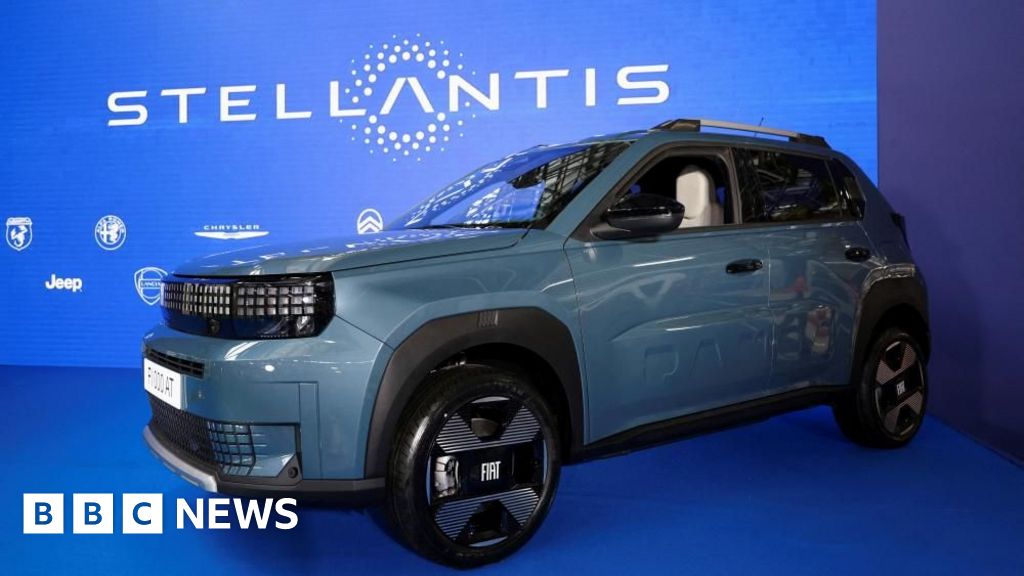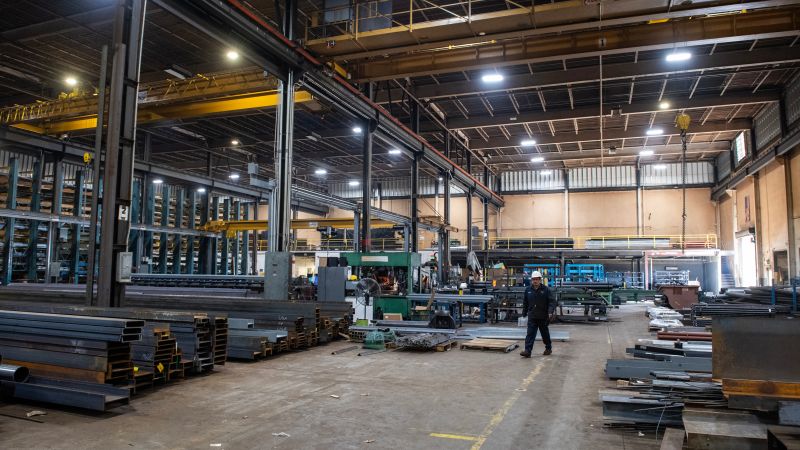The Impact of US Tariffs on the Automotive Industry

Introduction
The global automotive industry has been greatly impacted by the ongoing trade war between the US and China. One of the biggest players in the market, Stellantis, has recently revealed the impact of the US tariffs on its operations.
Key Details
According to Stellantis, the company has incurred a whopping €300 million in additional costs due to the 25% tariff on cars imposed by former President Trump. This has primarily affected the trade of popular brands like Vauxhall, Jeep, and Fiat, which are all under the Stellantis umbrella.
The company further revealed that the tariffs have resulted in a significant decrease in sales and profitability. This has also affected the company's ability to invest in new technology and innovation, as it struggles to manage the added financial burden.
Impact
The impact of the US tariffs has not only affected Stellantis but also the entire automotive industry. With the rise in production costs, companies are forced to increase car prices, making it difficult for consumers to afford new vehicles. This has also affected the job market, with companies cutting down on production and employment due to the decrease in sales.
The ongoing trade war and its consequences have highlighted the need for a more sustainable and fair global trade system, where all parties can thrive without being hindered by tariffs and other barriers.
About the Organizations Mentioned
Stellantis
Stellantis is a global automotive powerhouse that emerged in 2021 from the merger of the French PSA Group and Fiat Chrysler Automobiles (FCA), itself the product of earlier mergers between Fiat and Chrysler[2]. Headquartered in Hoofddorp, Netherlands, with its CEO operating from Auburn Hills, Michigan, Stellantis is now the world’s fifth-largest automaker by sales volume, trailing only Toyota, Volkswagen Group, Hyundai Motor Group, and the Renault–Nissan–Mitsubishi Alliance[2]. The company’s portfolio encompasses 14 iconic brands—Abarth, Alfa Romeo, Chrysler, Citroën, Dodge, DS Automobiles, Fiat, Jeep, Lancia, Maserati, Opel, Peugeot, Ram Trucks, and Vauxhall—and two mobility arms, reflecting a diverse and multinational heritage[1][2]. Stellantis is not merely a traditional car manufacturer; it is transforming into a sustainable mobility technology company. Its “Dare Forward 2030” strategy outlines ambitious goals, including achieving carbon net zero by 2038 and leading in electrification and software development[1][3]. The company is investing heavily in autonomous, connected, electrified, and shared mobility, as well as commercial vehicles and even electric aircraft, aiming to deliver value for all stakeholders[1]. With industrial operations in over 30 countries and a commercial presence in more than 130 markets, Stellantis employs a workforce of around 300,000 people, making it one of the most globally diverse companies in the industry[1][2]. Financially, Stellantis faces headwinds in 2025, with net revenues down 13% year-over-year in the first half, primarily due to challenges in North America and Europe, though it reports sequential improvements and a renewed focus on profitable growth under new leadership[4]. Despite these challenges, Stellantis is executing significant strategic investments
Vauxhall
Vauxhall Motors Limited is a historic British automotive manufacturer headquartered in Coventry, England, known for producing passenger cars, electric vehicles, and light commercial vehicles. Founded in 1857 initially as a pump and marine engine maker, it evolved into an automobile manufacturer by 1903. Vauxhall became part of General Motors in 1925 and was later acquired by the French PSA Group in 2017, which merged into Stellantis in 2021, situating Vauxhall within a global automotive powerhouse[1]. Throughout its history, Vauxhall transitioned from a luxury car brand to a mass-market manufacturer, aligning closely with Opel in Germany for engineering and model design since the 1980s. The brand has a notable motorsport heritage, including participation in rallying and the British Touring Car Championship[1]. Today, Vauxhall is a leader in vehicle electrification in the UK, offering fully electric versions of all its vans since 2021 and a fully electric lineup across cars and vans since the end of 2024[3]. In 2025, Vauxhall continues to innovate with its latest concept car unveiled at IAA Mobility 2025, featuring performance-oriented design elements tied to its GSE sub-brand, showcasing the brand’s commitment to blending racing technology with modern aesthetics[2]. The 2025 lineup also emphasizes fresh design, advanced technology, and improved performance tailored for UK drivers[4]. Vauxhall’s commitment to customer experience is highlighted by winning the 'Best Fleet Website' award at the 2025 Business Car Awards for the third consecutive year, reflecting its strong digital presence and customer engagement[3]. The brand also enjoys significant acclaim with the Vauxhall Astra named the 2025 Auto Express Power Driver Family Car of the Year, praised for its design, comfort, and availability in petrol, plug-in hybrid, and electric versions[6]. Vauxhall leverages innovative technology through its Pure Technology initiative
Jeep
Jeep is a renowned automotive brand best known for its durable, versatile 4x4 vehicles that excel in off-road and everyday driving conditions. The brand originated during World War II when the U.S. military sought a rugged, four-wheel-drive vehicle for combat. After evaluating several manufacturers, Willys-Overland secured the contract in 1941 to produce the Willys MB, the first military Jeep, which became iconic for its agility, toughness, and ability to traverse difficult terrain, playing a crucial role in Allied victories worldwide[1][2][3]. Post-war, Jeep transitioned from military to civilian markets, launching models like the Jeep Station Wagon (1946) and Jeepster (1948), establishing itself as a leader in 4x4 technology and recreational vehicles[4][5]. The brand's reputation for off-road capability and adventure grew through the 1950s and 1960s, highlighted by innovations like the Jeep Wagoneer, which combined ruggedness with luxury, expanding Jeep’s market appeal[5][6]. Jeep underwent several ownership changes: acquired by Kaiser Motors in 1953, then American Motors Corporation (AMC) in 1970, and finally becoming part of Chrysler in 1987, which later merged into Stellantis. Each transition helped Jeep evolve technologically and commercially, maintaining its leadership in four-wheel-drive vehicles and expanding globally[4][9]. Today, Jeep continues to innovate by integrating advanced technologies like 4xe electric vehicle technology, blending its legendary off-road capability with modern sustainability trends. The brand remains symbolic of freedom, authenticity, and adventure, nurturing a passionate global community and continuing to expand its lineup across multiple segments[3][5][8]. Notable for its military heritage and pioneering role in off-road vehicles, Jeep’s legacy is deeply embedded in automotive history, making it a respected icon in both business and technology spheres. Its slogan "Go Anywhere. Do Anything." reflects its enduring commitment t
Fiat
## Overview Fiat, officially Fabbrica Italiana Automobili Torino, is one of the world’s oldest and most storied automotive brands, established in Turin, Italy, in 1899[7]. Renowned for its distinctive Italian design and engineering, Fiat has played a pivotal role in making personal mobility accessible, especially through its compact city cars and light commercial vehicles[7]. Today, Fiat is a global brand under the Stellantis umbrella, with a strong presence in Europe, South America, and emerging markets, and remains Stellantis’ best-selling brand, moving over 1.2 million vehicles globally in 2024[7]. ## History Fiat’s journey began with a group of entrepreneurs seeking to industrialize automobile production in Italy[2]. Early models featured hand-engraved brass parchments, but as the company grew, its branding evolved to reflect contemporary design trends like Art Nouveau[2]. The 20th century saw Fiat become a symbol of Italian industrial prowess, constructing landmark factories like Lingotto—Europe’s largest car plant at the time—and expanding its lineup to include a variety of passenger and commercial vehicles[5]. ## Key Achievements Fiat’s most iconic achievement is the Fiat 500, launched in 1957. This diminutive car, with its rear-mounted air-cooled engine, became a global symbol of Italian style and ingenuity, embodying “la dolce vita” and democratizing car ownership in post-war Europe[1]. The 500’s 2007 revival, and subsequent electrification (including the 2022 New 500e), highlight Fiat’s ability to blend heritage with innovation[1]. The company has also been a leader in sustainability, committing to accessible, environmentally responsible mobility[7]. ## Current Status Today, Fiat is a key pillar of Stellantis, the multinational automotive group formed from the merger of Fiat Chrys






